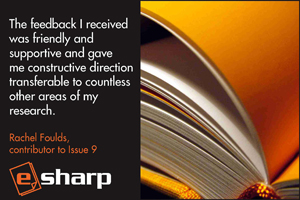The Reviewing and Selection Process
The Reviewing and Selection Process
- What happens to papers after they have been submitted to eSharp?
- How does the peer review process work?
Rejection without review
Due to the high volume of submissions, we cannot send papers out to review if they do not comply with our submission guidelines. Grounds for initial rejection are as follows:
- Lack of engagement with title
- Unacceptable standard of English
- Failure to adhere to submission guidelines:
- title
- abstract
- keywords
- references (only Harvard references using the system in our Style Guide will be accepted)
- word limit
- format (major faults)
However, re-submission is permitted within the published deadline.
Peer reviewing
Once the deadline for submissions has passed, all received papers are sent out for review. We assign two reviewers to each paper, making sure that those reviewers have a degree of expertise in the subject matter dealt with in the article. The whole process is anonymous (or 'double blind') so reviewers will not know whose article they are reading, nor will authors know who reviewed their work.
The reviewers will analyse the paper using the Peer Review Pack developed by eSharp. It is advised that submitters familiarise themselves with this document before sending in their work. Following our guidelines, each reviewer will annotate the article using the 'comment' function of Word then prepare a feedback report for the author, and a decision report for the eSharp board. The decision they make will be figured by a grade of 1-4 whereby:
- Accept without revision
- Accept subject to minor revisions
- Accept subject to substantial revision
- Reject
Each article is also read by at least one member of the eSharp board to ensure consistency in standards of writing and reviewing.
 The selection process
The selection process
The decisions reached by the board are final. They will be communicated to authors immediately after the selection meeting. Whether they are accepted or rejected, authors will receive two fully annotated copies of their work as well as two detailed feedback reports.
Some articles will be accepted subject to minor or substantial revisions and will be given a specified time within which to make the changes. These revisions must be made or the article will not be published.
Copy-editing
The successful authors will be asked to re-submit by a given deadline, after which their paper will be copy-edited. The editor will make sure that the required changes were made in addition to preparing the copy for print. When this has been done, the article will often be passed back to its author for a final proof check. At this stage we are not asking for alterations or amendments, but rather sending them an indication of how their article will appear.
A word on deadlines
At eSharp we operate a turn-around time of less than six months for submitted articles. This means that our deadlines have to be strictly adhered to. Late submissions at any stage could result in non-publication.

